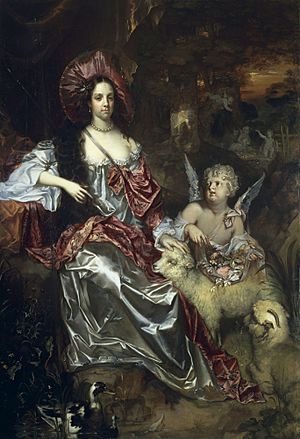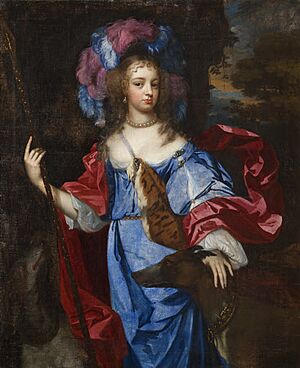Jacob Huysmans facts for kids
Jacob Huysmans (born around 1633, died 1696) was a talented Flemish artist. He was known for painting portraits. After learning his skills in his home city of Antwerp, he moved to England before the time known as the Restoration. He became a very popular painter at the royal court. He was especially liked by Queen Catherine of Braganza, who was from Portugal and shared his Catholic faith. He painted many pictures of her. Huysmans had a lively and exciting painting style. During his lifetime, many people thought he was a strong competitor to the main court painter, Peter Lely, who used a calmer style.
Contents
Life of Jacob Huysmans
Jacob Huysmans was likely born in Antwerp. Several people in his family were also artists. His nephews, Cornelis and Jan Baptist Huysmans, were both landscape painters. Huysmans learned to paint in Antwerp. He was taught by history painters Gillis Backereel and Frans Wouters.
Huysmans moved to England. Some say he arrived before the Restoration in 1660. We first know he was in England in 1662. When he first arrived, he painted smaller copies of historical scenes by Anthony van Dyck. Later, he became a successful portrait painter at the court of King Charles II. Because he was a Roman Catholic, Queen Catharine of Braganza, who was also Catholic, especially favored him.
The famous writer Samuel Pepys visited Huysmans' studio in Westminster on August 26, 1664. Pepys called him 'Hiseman' and said he was a 'picture-drawer ... which is said to exceed Lilly (Lely)'. Pepys thought Huysmans' paintings of the Queen and her maids of honor were some of the best he had ever seen. The painting Queen Catharine as a Shepherdess (around 1664, British Royal Collection) was one of the pictures Pepys saw that day. He also saw a painting of the Queen as St Catherine of Alexandria.
While Huysmans spent most of his career in London, he lived in Chichester in Sussex for a while after the Great Fire of London. He might have moved to avoid the danger of people being angry at Catholics in London at that time. Some people wrongly blamed Catholics for starting the fire.
Huysmans passed away in Jermyn Street, London, in 1696. He was buried in St. James's Church in Piccadilly. He had painted an altarpiece for the Queen's chapel in that church.
Jacob Huysmans' Artworks
Painting Styles and Subjects
Jacob Huysmans mainly painted portraits. When he first came to England, he also used his skills to create smaller religious and mythological scenes. These were often inspired by Anthony van Dyck. Even after becoming a famous portrait painter, he still painted historical subjects. He also created religious paintings for his supporter, Queen Catherine of Braganza. His religious and historical paintings were calmer in style than his portraits.
Huysmans' painting style is described as very lively and full of energy. This made his art especially appealing to Queen Catherine. His use of paint and colors was similar to the Italian Baroque style of Anthony van Dyck. He used bright, strong colors and painted skin tones with reddish highlights. His paintings had a smooth, shiny finish.
Huysmans was very good at showing the rich colors and textures of fancy clothes worn at court. He loved to show how light, color, and different textures played together. For example, he would paint crumpled satin next to smooth skin or shiny curls mixed with jewel-like flowers. Huysmans often painted people in costumes, with props, in dramatic settings. He also included symbols that told a story. The grand feeling in his portraits reminds us of the Italian painter Guido Reni.
Portraits of Women and Children
Huysmans painted many women as shepherdesses. Their clothes were often decorated with embroidery and jewels. He also often showed women as religious figures or characters from old stories. For example, he painted three women as the Roman goddess Diana. These include Lady Elizabeth Pope as Diana and Elizabeth Cornwallis, Mrs Edward Allen, as Diana the Huntress.
These Diana portraits usually show the goddess with a hunting spear and some hunting dogs. The paintings aimed to show the beauty, purity, and innocence of the person. The way Diana is posed, and the dogs with star-decorated collars, might refer to the Virgin Mary. In Catholic art, Mary was often shown with a crown of stars.
Huysmans also painted children in a similar gentle, outdoor style. One example is the Portrait of Edward Henry Lee, 1st Earl of Lichfield, and his wife Charlotte Fitzroy as children. This painting shows Edward Henry Lee and Charlotte Fitzroy as children. Charlotte was the daughter of King Charles II. The painting includes hidden symbols related to the Catholic faith, which was not allowed at the time. For instance, the peacock in the painting can symbolize the resurrection of Christ.
Portraits of the Queen
Queen Catherine was one of Huysmans' most important supporters. He painted many portraits of her. In 1683, Catherine also asked him to create a beautiful altarpiece for her Chapel in St James’s Palace. The large number of portraits Huysmans painted of the Queen and her maids of honor suggests he was her main painter. Perhaps the Queen preferred Huysmans to show her independence from her husband's mistress, who favored Lely.
His painting Queen Catharine as a Shepherdess (around 1664) is one of his most famous works. It's the one Samuel Pepys saw and praised so much. In this painting, Catherine is shown as a shepherdess, sitting by a stream. An orange blossom in her hair symbolizes love and marriage. Her left hand rests on a lamb, which might symbolize innocence and humility. A small Cupid brings her flowers, and other Cupids play in the trees.
Another portrait of the Queen seen by Pepys was a painting of her as Saint Catherine of Alexandria. The Queen was born on Saint Catherine's feast day. Being painted as the saint became a popular way for ladies at court to show respect to the new Queen. In this painting, the Queen is shown with a martyr's palm in her right hand. Her left hand rests on the broken wheel, which was used to try and harm the Catholic saint.
Portrait of John Wilmot, 2nd Earl of Rochester
Another well-known painting by Huysmans is the Portrait of John Wilmot, 2nd Earl of Rochester. Rochester was a famous poet and courtier at King Charles II's court. This painting was likely made not long before Rochester passed away.
Rochester is thought to have helped design parts of the painting, especially the monkey. Rochester was known to have a pet monkey, which was probably the model for the painting.
In the painting, Rochester holds a paper in one hand. With the other, he seems to be giving a poet's laurel wreath to a monkey. The monkey has torn pages from a book and is giving them back to the poet. Monkeys often appear in Rochester's writings. There, they symbolize how foolish and arrogant people can be. So, the painting might be a funny and humble way for Rochester to show himself.
Some art experts have different ideas about the portrait. They suggest it might be a playful jab at John Dryden, another English poet. Rochester and Dryden had a difficult relationship. In this view, Rochester's right hand is taking away the laurel, not giving it. When someone is crowned with a laurel, it's usually done with both hands. So, the monkey could represent John Dryden, and Rochester is "de-laureling" him.





